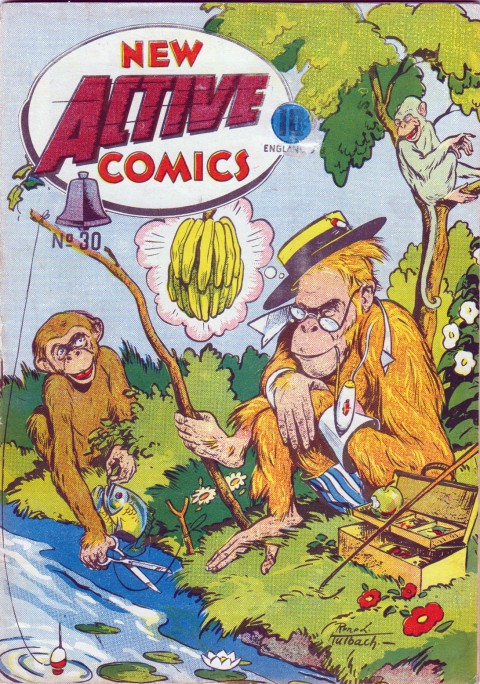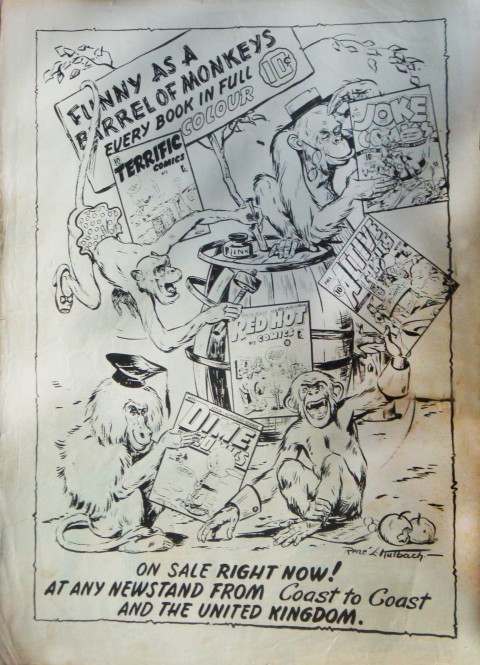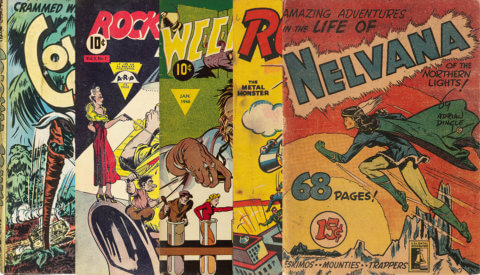
1946 was the twilight year of denouement for Canadian war time comic books. With their slick American counterparts back in the swimming pool, they had lost some of the lustre that the protection of the Canadian government had afforded them. In this post, I want to take a closer look at what was happening at Bell Features during this time of turmoil and surrender for the Canadian Whites.
We know that Cy and his brother Gene had founded the company as Commercial Signs of Canada in 1929. It produced signage in Ontario for a dozen years before, in the late summer of 1941 and with the prompting of E. T. Legault, it shifted gears and put out Wow Comics No. 1. Then, on March 17, 1942, halfway through its development of its six other core titles, the brothers incorporated the company as Bell Features and Publishing Company Ltd. using its familiar bell logo.
Early in 1945 the Bell brothers decided to meet the impending return of full colour American comics by taking the steps to establish a printing plant that could produce full colour comics to meet those American comics head on. We now know that Bell Features wasn’t the only Canadian comic book publisher to recognize and respond to this same situation. Anglo-American Publications began to print in full colour by the summer of 1945 and by the start of 1946 Maple Leaf Publishers were also able to put out a couple of full colour issues.
Here is a paragraph from a letter written by Cy Bell in January of 1946 that is in the Library and Archives holdings in Ottawa: “To meet the competition of the re-entry of the American periodicals and wishing to create a new Canadian industry employing Canadian craftsmanship, we incorporated a new Company and interested new capital in our new organization, The Rotary Litho Company of Canada.”
This letter was written on Rotary Litho letterhead. The implication then is that The Rotary Litho Co. of Canada was in place as a corporate entity in the first quarter of 1945 and its mandate was clear.

Cy Bell noted that, in the same letter, that there wasn’t a “…single Commercial Establishment in the entire Dominion of Canada that could print four colour work on each side of a web of paper 68” width.” despite the fact that Anglo-American was able to go full colour in the summer of 1945 making use of the Globe and Mail presses. Perhaps Cy’s vision was a bit of a different process than that used by Anglo-American.
In any event, Cy found the press he needed in March 1945 in Cleveland and had it dismantled, crated and shipped to a Toronto warehouse in seven freight cars. The press itself was over 7.5m tall, 20m long, and just over 7m wide. Quite an imposing piece of machinery and Cy had to find a production building not only to house the press but to have room enough for a complete photo-engraving plant, a stereotype department and bindery that could output half-a-million comics a week.
It seems that by the early fall of 1945, Cy had found the location he needed. It took three months to reassemble the printing press there as well as set up the rest of the production process but, by the end of January, 1946, Cy Bell and Rotary Litho were set to go. In that same letter that I take all this information from, Cy lists the following companies among others that had already approached him for press time, bindery time, and distribution:
- The Montreal Standard in Montreal
- The Hearst Publishing Co. in New York City
- The Thompson Publishing Co. in Toronto
- The Magazine Digest Publishing Co. in Toronto
- The New World and Illustrated in Toronto
- The Fawcett Publishing Co., in New York City
Rotary Litho was set to employ about 110 individuals, including a stable of 35 artists and writers and Cy Bell made the point that many of these employees would be people returning from military service abroad. The proposed operating pay roll of the company was an annual $200,000.

I believe it was in this positive atmosphere of expansion that Cy Bell began to plan his full colour issues gallery. There are notes in his papers at The Library and Archives proposing new titles such as Extra Comics, Novel Comics, Sharp Comics, Global Comics, and Mountie Comics but his notes show he chose to register the copyright the following titles in 1945-6 (Cy Bell’s own noted date of publication in brackets):
- Colossal Comics (First published April 11, 1945)
- Young’s Whittle Craft (First published July 16, 1945)
- Giant Comics (First published Aug. 17, 1945)
- Jumbo Comics (First published Sept. 14, 1945)
- Terrific Comics (First published Nov. 16, 1945)
- F.B.I. Comics (First published Nov. 19, 1945)
- Jet-Man Comics (First published Nov. 19, 1945)
- Slam-Bang Comics (First published Nov. 27, 1945)
- Red Hot Comics (First published Nov. 27, 1945)
- Doodlebugs (On sale as a comic book Nov. 27 1945)
- Unusual Comics (First published Dec. 18, 1945)
- Comic Crimes Comics (First published Aug. 14, 1946)
- Smasher Comics (First published Aug. 14, 1946)

Cy Bell also renewed the copyright on 6 of the 7 core Bell Titles leaving out the renewal of Wow Comics which was not assigned to Bell Features like the rest but in Cy’s words was “given to Fawcett.” It’s clear that Cy’s push was going to be into the States and he was going to draw the battle line there. The States already had a title called Wow Comics and it belonged to Fawcett. The final issue of Bell’s Wow Comics, No. 30, probably appeared on the stands toward the end of 1945 and it was never filled with American reprints like many of the other core titles. I suspect Commando Comics wasn’t continued because Cy Bell didn’t think a war title would be popular after the war and Manny Easson never transferred the rights to The Funny Comics and his Dizzy Don character to Cy Bell and started publishing it himself after issue No. 20. Elsewhere in his notes, Cy Bell also gave up on the idea of distributing Active Comics in the States because its title sounded too much like Action Comics.

Finally, Cy Bell also indicates in these notes that he copyrighted other titles such as Johnny Canuck, The Brain, Capt. Wonder, Nitro, and The Dreamer at this same time around Nov. 27-8 1945.
Of this long list, I believe Comic Crimes and Smasher Comics were mainly made for distribution in Britain and they are seldom found without evidence of a British price sticker on them. Colossal Comics and Young’s Whittle Craft did see the light of day as normal, newsstand releases but I have never seen any copies or other reference to Bell Features’ comics with the titles Giant or Jumbo. Slam-Bang Comics did appear on the stands with the cover number 7 and an indicia date of May, 1946 and turned out to be the only Bell post-core 7 titles comic to feature original Canadian material. Unusual Comics No. 1 appeared on the stands with the indicia date of Sept.-Oct. 1946 containing colour American reprints.

The remaining titles on the above list are interesting because they can be set in juxtaposition to five strange comics held in the Bell Features Collection at the Library and Archives of Canada (LAC) in Ottawa. It has always been a mystery to WECA comics collectors why we could never find No. 1 issues of 1946 hybrid titles such as Terrific Comics, Red Hot Comics, Jet-Man Comics, and F.B.I. Comics. Meaghan Scanlon, Special Collections Librarian at LAC, first mentioned these five strange comics with black-and-white covers, in comments to my last post. She was kind enough to send me scans of the front covers for these books with the proviso that I could not reproduce them in my column but that I could write about them.
There are five titles and they are all No. 1s: Jet-Man, Doodlebugs, The Brain, Terrific, and Red Hot. They all are filled, according to Meaghan, with the black-and-white guts of Triumph Comics No. 29. It appears that these were examples of unique, prototype ashcan copyright place holders, quickly knocked together to secure copyright both in Canada and the United States. Probably only one copy of each exists and those copies that finally appeared on the newsstands some months later in 1946 all had to be numbered No. 2s.
LAC has five of these unique comics obtained when they purchased the warehouse collection from Patrick Loubert and Michael Hirsch. Who knows how many others were made? The No. 1 for Johnny Canuck Comics, which also came out as a No. 2, must have been made, for example, but it is not in this collection. There are also titles such as Captain Wonder Comics and The Dreamer Comics which are mentioned in some back cover ads.

The Jet-Man ashcan cover is identical to the Fred Kelly cover that was published except that it has a “No. 1” just over the large “ET” of the masthead and no “No. 10” as was published.

The cover of the copy of The Brain No. 1 is a black-and-white reprint of the cover for Active Comics No. 22 with Dingle’s signature near The Fox’s outstretched arm removed, the No. 22 replaced by the Bell logo and a 10₵ price marker and a large No. 1 flanking the word “The” which is just above the word “Brain” in the masthead.

The Doodlebugs No. 1 reprints in black-and-white the cover of Joke Comics and again Dingle’s signature as “Darian” has been removed from the cover. “The Doodle Bugs” title under the feet of the two upright Doodlebugs has been removed from the Joke cover and the “Joke Comics” masthead has been replaced by “The Doodlebugs Comics” with the No. 1 fitted in between the word “Doodlebugs,” which slopes up from the left, and the space created between it and the smaller horizontal “COMICS” which stretches just above the heads of the two vertical doodlebugs. The Bell logo has been moved to just under the feet of the middle doodle bug. Also the hanging stalactites have also been removed from the Joke cover.

The remaining two covers feature otherwise unpublished Fred Kelly artwork with the F.B.I. Comics No. 1 showing a scruffy, sneering, knife-brandishing bad guy stepping through an open kitchen window to confront a startled housewife in the foreground who has just let go of the full pot in her hand.
The Red Hot Comics No. 1 cover is a Fred Kelly pirate cover reminiscent of his work on The Blade in Joke Comics. A bearded pirate is stepping over the rail of a ship brandishing a cutlass in his right hand and a dagger in his left. On the burning deck below a fair-haired hero waits to take him on with the same weapons in his own hands.
Having these mock-ups printed to secure copyrights, securing the four-color printing press, and establishing a plant to take those incoming American comics head on meant that Cy Bell had solid plans for the survival and growth of Canadian comics. Bell Features hadn’t decided to just roll over and die when the American Comics were let back in… but then, what did go wrong?
Here is an excerpt from that same letter of Jan. 30, 1946 on Roto Litho letterhead that explains much:
In setting up this whole project we were given to understand by paper merchants that after the war was over and all restrictions were lifted that we could secure a steady flow of paper from the mill. We have completed a personal survey of all the paper mills in Montreal and Toronto and we cannot secure any supply of newsprint or cover stock due to the fact that we are not on the allocations list of Canadian Consumers and being a new Company we have no allocations. We have been given to understand that there is an allotment of 17,500 tons of Newsprint per month set aside for Canadian consumers of newsprint, but that no provision has been made to supply new Companies.
Cy had the printing plant in place but couldn’t get any paper. He looked all over Ontario and Quebec without any luck. No paper was available to new companies not only for the above reason but also that whatever paper was available could be sold to American companies at a price point higher than what new Canadian companies were prepared or able to pay. All extra paper was flowing south across the border. Our mills were not taking any orders from new Canadian companies and Cy wasn’t able to obtain one single roll of paper.
There is quite a record of Cy Bell’s desperate and fruitless “paper chase” in his correspondence to mills across the country in the last half of 1945. Cy had put together a company that was willing to employ Canadians and was more than willing to spend money in Canada for Canadian products but his reasoning and pleas fell on deaf ears. As usual a short window of profit won over any idea of a big picture sustainability and growth. Some things never change… That’s why most of us have never heard of Rotary Litho and that’s why, in 1946, we ended up with a bunch of lame American funny animal and Chesler colour reprints instead of a newsstand full of variations on Slam-Bang Comics No. 7 and Super Duper Comics No. 3 from Bell Features.





Thanks for the descriptions of those ashcan covers Ivan.
FYI – Rotary Litho was eventually located at 60 Jarvis St., after that letterhead was made, and printed such comics as Milt Gross funnies.
That’s a sad ending to a wonderful uplifting body of work in a depressing time of war that was unappreciated by a government who controlled the paper supply.
Its too bad we can’t see these ashcan covers in addition to your descriptions but I understand LAC wanting to protect what they have.
They would make a great addition to a Canadian Golden Age comic public presentation if we are ever lucky enough to see something like this in cities or comic conventions in the near future.
There is a book called Jumbo Comics that was published by B & G Publishing in 1948 with material that was published under Pioneer Publications etc that may be what made it to the newsstand in the end after Rotary Litho failed in its plans.
http://www.canadiangoldenagecomics.com/images/JumboComics_1_CGC6.5.jpg
Thanks for this additional factum, Jim B. I’ll be looking at the indicia of those post-WECA comics more closely from now on.
Thanks for your comment too, Jim F. I think that you are right, it’s time (40+ plus) years since the last travelling LAC exhibit and we could certainly do with something like this again now that the knowledge base concerning these comics has increased and the interest is higher than ever.
There is Jumbo Comics cover that has a distinctive stylized art – looks like none other than Manny Easson’s work, Bell Features’ Funny Comics creator . It’s unusual to see a cover by him that wasn’t a Dizzy Don, but this is more of a circus themed image.
Hi Ivan, just read your post which is very interesting but felt I had to correct you about the No.1 comments you made. The red diamond is the UK price sticker of 1 Shilling, no longer legal currency in the UK but worth quite a bit in 1946 or so.
Thanks Peter, but the “No. 1” reference is to the cover of the black-and-white ash can Jet-Man No. 1 comic–a picture which I did not post. It does indeed have a “No, 1” on the cover in the area I described. I wasn’t at all referring to the picture of the Jet-Man No. 2 cover which has that bright red one shilling sticker on it. Remember, Peter, I was born in Blackburn and grew up in England during the fifties and had a few large farthings, large pennies, tuppences and in my pockets, seldom a shilling or even a sixpence coin though.